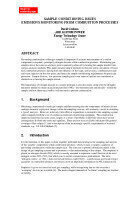Air Monitoring
SAMPLE CONDITIONING ISSUES EMISSIONS MONITORING FROM COMBUSTION PROCESSES
Oct 06 2014
Author: David Graham on behalf of CEM
ABSTRACT
Preventing condensation within gas samples is important if accurate measurement of a soluble component is required - principally nitrogen dioxide within combustion products. Maintaining gas samples above the water or acid dew point is normally achieved by heating the sample transfer lines and gas analyser modules. This paper presents simple methods for the dew point calculation of fossil fuel combustion products and explores the influence of fuel type, air:fuel ratio, combustor pressure and water injection on the dew point, and hence the sample conditioning requirements for particular processes. Sample dilution, low pressure sampling and water removal options are considered as
alternatives to heating the sample stream.
The importance of nitrogen dioxide as a source pollutant is also discussed, along with the stringent measures needed to obtain an accurate partition of NOx - into the monoxide and dioxide - within the sample and how these may conflict with the need to prevent condensation.
1. Background
Obtaining a representative stack gas sample and then ensuring that the components of interest do not undergo chemical or physical change within the sampling train are, self-evidently, crucial in obtaining a ‘good’ analysis. However, relatively little effort or expenditure is invested in the sampling system when compared with the cost of continuous emissions monitoring equipment. This situation has improved somewhat in recent years, largely as a result of problems in the field which have severe consequences for both end users and suppliers. There are now texts available which provide general coverage of this subject [1] and a description of the increasingly specific requirements of national standards, e.g., U.S. EPA Methods [2].
2. Introduction
It is the intention, in this paper, to draw together published data relating to the sampling and analysis of the ‘soluble’ components within combustion products which, in turn, is largely a question of preventing condensation within the sample train. The aims are to present information useful in the design of gas sampling systems and to promote a wider understanding of the subject. The emphasis is placed on nitrogen dioxide (NO2) which is usually assumed to represent a small fraction of the total nitrogen oxides (NO + NO2) but which can, in certain circumstances, predominate. The term ‘nitrogen oxides’, or ‘NOx’, does not include nitrous oxide (N2O) - a green-house gas found in trace quantities in combustion products and which can be an important intermediate in NOx formation [3].
Emphasis is given to extractive stack gas sampling, whilst recognising that in-situ cross-duct ‘averaging’ devices are available [4]. The more stringent demands of ‘in-flame’ sampling are touched on briefly.
Digital Edition
IET 34.2 March 2024
April 2024
Gas Detection - Biogas batch fermentation system for laboratory use with automatic gas analysis in real time Water/Wastewater - Upcycling sensors for sustainable nature management - Prist...
View all digital editions
Events
Apr 30 2024 Melbourne, Australia
Apr 30 2024 Birmingham, UK
May 03 2024 Seoul, South Korea
May 05 2024 Seville, Spain
May 06 2024 Minneapolis, MN, USA















